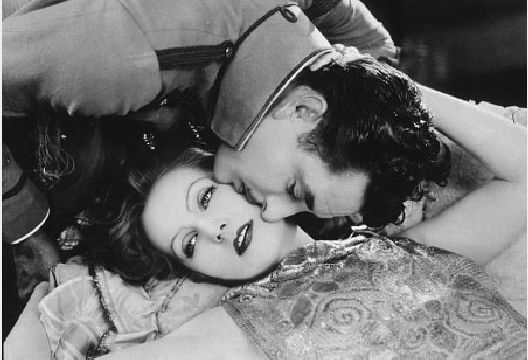Flesh and the Devil (1927) 

Director: Clarence Brown
Cast: John Gilbert, Greta Garbo, Lars Hanson
Synopsis: Childhood friends are torn apart when one of them marries the woman the other once fiercely loved.
At the time of viewing The Flesh and the Devil I wasn’t a huge fan of silent movies; unlike even the early talkies, the very fact of their silence seemed to distance them from the present day to such a degree that watching a silent movie was like viewing people and incidents from another, inaccessible, world — one in which postures and expressions were grossly exaggerated, and movements often decelerated to the point of painstaking deliberation.
While The Flesh and the Devil suffers from all of the above, it also contains such visually pleasing moments and memorable imagery the viewer can, if not overlook, at least tolerate, the aforementioned irritations. The movie is literally teeming with such wonderful moments: Garbo and Gilbert’s faces illuminated by his lit match; the silhouetted hand of Garbo’s cuckolded husband in the foreground engulfing the kissing couple in the background as it clenches into a fist; the swirling patterns on Garbo’s skin as she stands at a rain-lashed window; the stark chiaroscuro effect employed for the duel scene; the leisurely shot of the railway station platform we see with Leo and Ulrich from their compartment.
The storyline was probably cliched even back in 1927. John Gilbert and Lars Hanson play Leo and Ulrich, childhood friends, and blood-brothers who, as they grow up, spend a worrying amount of time hugging each other (which is perhaps telling of the movie’s subtext when one considers subsequent plot developments and the timing of the twist ending). Such worries are soon calmed, however, when Leo falls for the mysterious Felicitas (Garbo). Soon, Felicitas threatens to destroy the men’s friendship as a bitter love-triangle develops.
Without the luxury of sound, Director Clarence Brown skilfully hints at the emotions and conflicts raging within the main characters with nothing more than a look or simple action: Ulrich fumbling his matches as he attempts to light Felicitas’ cigarette; Felicitas and Leo’s shared glance before drinking a toast while Ulrich unknowingly nurses a wounded finger, and, most tellingly perhaps, the manner in which Garbo consumes her wine during communion — that scene alone is reason enough to watch this movie!
Garbo’s beauty, like that of Louise Brooks, was ahead of its time; but, unlike Brooks, Garbo used this to her advantage. Despite her tendency to indulge occasionally in histrionics, I’ve always thought Garbo’s wonderful screen presence was captured better in her silent movies; she possessed the most wonderful face that somehow expressed emotions with nothing more than a glance, the lowering of her eyes, or the curl of her mouth. And, in this movie, while she hints to the viewer about the true nature of her character some scenes before the hapless Leo discovers for himself, it is, nevertheless, a stunning revelation.
(Reviewed 7th May 2002)
httpv://www.youtube.com/watch?v=Hr2ehyOz2Ms
